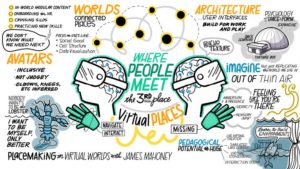
LILA April Member Call
Virtual Places
How designers of virtual reality spaces think about creating a sense of place
James Mahoney, Dartmouth College
To listen to audio link please click here.
James Mahoney is currently a senior lecturer and research scientist at Dartmouth College in the Computer Science department. His focus is on digital arts and more specifically Augmented and Virtual Reality design and development, as well as generative design. He has a background in architecture and animation including degrees from Cornell, and work at Hanna-Barbera Productions, Microsoft Research and Meta.
Summary of Presentation
Virtual worlds are online spaces that are interconnected where people can go from place to place. Some may refer to virtual worlds as third places since these are places that are not what we call home or the work office, where people come together to enjoy and socialize. After creating a virtual world with his students at the SilVR (Social Interaction Laboratory) at Dartmouth University to create a virtual place where students could show their work, it was evident that virtual places need to be compiled in one infrastructure or server to be interconnected. This is not possible yet, but it is critical because virtual worlds are made by creating a collection of interconnected places.
Some places have been built to share stories, values, and dreams, to influence people, entertain, socialize, and to foster play, learning, making and sharing with others. This purpose of place is also possible in third places that are online because after removing the practical aspects of a physical space what’s left is the meaning of the space and the kinds of behaviors expected at the space. Spaces are really about the psychology of how they feel and the emotional tone they evoke, rather than the practicality of the “shelter” they offer.
When exploring a new place, it is common to try to recreate what is already known, instead of asking what could be done that is unique and meaningful in this new space or what can this new place enable. Therefore, what is unique about virtual spaces is that things that are done or that happen in the real-world can´t necessarily be replicated such as the sense of touch and other out of body experiences, but through imagination other new actions, representations and activities may emerge and be explored.
Questions and comments from the members:
- How do we balance solving for something we don’t know yet vs finding solutions based on things that are known?
- We try to replicate the places that we know in VR or new places, instead of seeing what a new place will enable us to do
- VR spaces could enable the exploration of what other teams are doing within the same organization.
- VR affordances at organizations: socializing in a third place, decrease the threat of asking questions to an avatar compared to a real human, breaking down silos
- Should we develop skills to experiment with VR? Where can we experiment?
- Virtual spaces may be used to practice different skills.

Add a comment